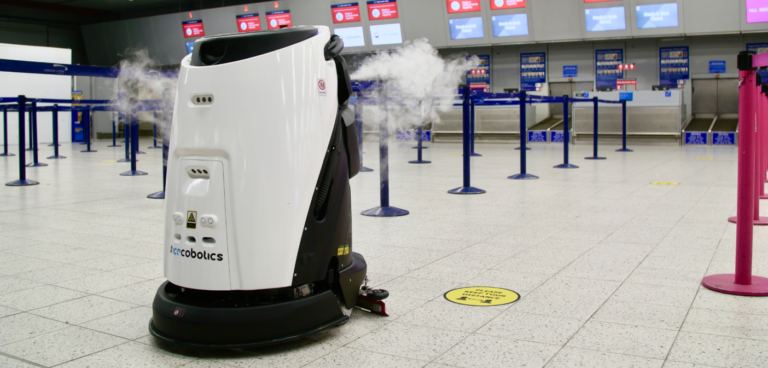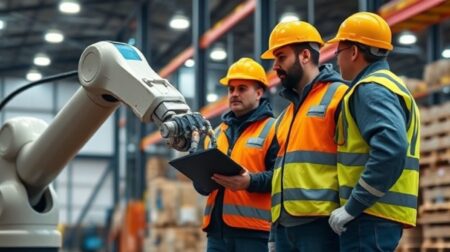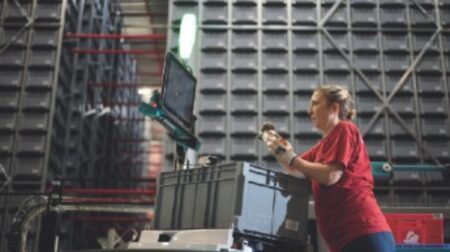Hospitals, retailers, offices and transport hubs across the UK have turned to robots to help keep public spaces clean and safe during the pandemic, but is the cleaning industry ready for them? Katie Searles reports…
Last year, the global pandemic saw businesses of all kinds scrambling for solutions to address sudden and unexpected labour and productivity changes, as well as enhanced cleaning expectations. One technology that has proved its value during the crisis is autonomous mobile robots (AMRs), which, thanks to clever in-built technology, can create cleaning routes on their own, be programmed to avoid certain areas and can adapt and improve with every clean to offer a highly effective and targeted cleaning solution.
In April 2021, a survey conducted by RetailWire and San Diego-based AMR AI software developer Brain Corp examined why retailers were fast-tracking in-store robotic automation technologies and found that one in four already had in-store robotic cleaners in place, while nearly half were planning to roll out service robots in the next 18 months.
According to Brain Corp, the results of the survey – titled Robots in Retails: Examining the Autonomous Opportunity – underscore the growing significance of robotic automation technology in the current pandemic marketplace, which are seen as key for assisting workers with a variety of tasks, from floor cleaning to shelf scanning, in all manner of facilities from stores, airports and warehouses to offices, stadia and hospitals.
And in addition to enabling human cleaning teams to work at a safe distance, robots are helping businesses face one particularly worrying emerging trend: labour shortages. Michel Spruijt, senior vice president for international business at Brain Corp, points out that the media estimates that as many as “300,000 people moved away from the UK” following Brexit, creating a labour shortfall”.
This view is echoed by Mitch Holmquest, robotics demonstrator at ICE, who says its healthcare customers are seeing “massive labour shortages” and are thus looking to implement robots as they struggle to hire staff. “We haven’t fully felt the effect of Brexit yet, hopefully this is a bad as it gets,” says Holmquest. “But there is always the potential that people won’t be willing to enter the cleaning industry. People don’t always regard the profession in positive light.”
However, Holmquest believes robot technology could help tackle this image problem. “The use of robotics is part of a wider journey to change the perception of the cleaning industry – it actually puts it a step above because of the way the technology is being integrated,” he says.
Collaborative by nature
Changing the negative perception of the cleaning industry as a whole is one challenge, but cleaning robot suppliers are also working to change the narrative that robots will replace the jobs currently performed by human workers. But are people right to worry? Could the rise in automated cleaning solutions mean dispensing with the human touch altogether? These concerns are why companies such as ICE and Brain Corp are keen to promote robotic cleaners as collaborative and as team members, rather than all-out replacements. Operating alongside human cleaning teams, these robots are designed to perform repetitive, time-consuming and, sometimes, strain-inducing tasks, all while collating data.
According to Spruijt, it is not about replacing humans, but freeing them to undertake more intricate duties. “You still need people! The robot takes 80% of the work, but there’s still so many things that need to be cleaned that cannot be cleaned by a robot,” he says.
“Because robots can be taught to repeat processes, the technology is ideally suited for scrubbing floors, while humans can concentrate on cleaning high touchpoint surfaces.”
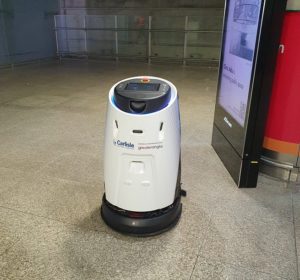
This is exactly what British train operator Abellio Greater Anglia did following the deployment of floor-cleaning robots at Stansted Airport train station last year, where the company invested more than £23,000 in an Eco Bot 50 robotic scrubber dryer from ICE via cleaning contractor Carlisle Support Services.
Fitted with more than 20 sensors and cameras, the robot can perceive its environment (mapping a 2,000m2 area in 30 minutes), avoid obstacles and prevent collisions while it quickly and efficiently cleans and dries platforms and concourses.
What’s more, the machine has been designed to be environmentally friendly and recycles water through an in-built four-stage filtration system to give constant operation during a 2.5-hour run time. It also doesn’t require any human intervention and automatically returns to its charging point when required.
“Our floor cleaning robot introduced a new level of efficiency that we wouldn’t be able to achieve without it,” says Krzysztof Drozd, station cleaning and waste manager at Abellio Greater Anglia. “It does all the work by itself and requires minimal supervision from operatives, which means we can programme the robot to handle a cleaning task while a human cleaner sanitises glazing in the waiting room, for example.”
According to Drozd, Abellio Greater Anglia has also introduced robotic vacuum cleaners at its offices, allowing cleaning teams to focus on public areas.
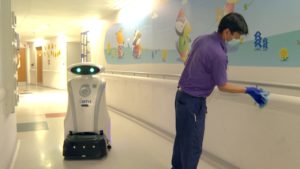
At Sherwood Forest Hospitals NHS Foundation Trust, which runs three hospitals in Nottinghamshire, its cleaning and support services provider, Medirest, partnered with cleaning innovation specialist, Killis, to develop two cleaning robots, called Alex and Hanzel, specially suited to the large open areas in hospitals such as corridors and ward areas.
Implemented permanently last summer at King’s Mill Hospital following a successful trial period, the robots support the hospital’s team of cleaners to enhance repetitive cleaning procedures in open spaces, freeing up other team members to focus on touchpoint areas such as handrails, lifts and entrance areas to wards.
Sally Palmer, lead nurse for infection prevention and control at Sherwood Forest Hospitals NHS Foundation Trust, says: “It is exciting to be able to have these cleaning robots at our King’s Mill site, particularly throughout the Covid-19 pandemic. Our colleagues were so busy ensuring our hospitals were clean and safe for patients, so having the support of the robots during the peaks of Covid-19 was greatly appreciated, and still is.
“We strive towards the highest levels on cleanliness at all times; this ensures our colleagues, patients and visitors are kept safe. The support of the cleaning robots enabled our cleaning teams to focus on key areas which needed to be cleaned regularly and thoroughly multiple times a day.”
Seen to be clean
While the above are examples of robotic cleaning technology being rolled out in response to, and during, the pandemic, there’s a growing belief that robot cleaners are here to stay as a growing cross-section of companies further incorporate these machines into their current operations and begin to put in place the resources and systems required to train operators and make a smooth transition to the new technology.
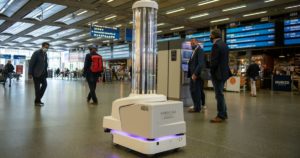
In fact, research firm Arizton Advisory and Intelligence predicts the autonomous floor scrubber market size will reach US$1.47bn (£1.1bn) by 2026. This growth could be in response to the changing nature of the cleaning industry itself. As businesses continue to emerge from various states of lockdowns and Covid restrictions there is a need to show higher and more transparent levels of hygiene.
According to Holmquest, businesses want – and need – to visually showcase that cleanliness is a major priority. This is why ICE’s Co-Botic range of autonomous cleaning machines feature docking stations that can be placed in reception areas, so that even when these cleaning robots aren’t working they are ever present. “We want our customers and theirs to feel totally safe and secure,” says Holmquest. “That means we must ensure the environment they’re in is clean. When people see clean floors and clean handrails, that’s all positive, and helps to create an opening for change in the cleaning industry.”
Furthermore, the end-users of such technology have also welcomed public interest in these cleaning systems, with both Sherwood Forsest Hospitals NHS Foundation Trust and Abellio Greater Anglia reporting genuine curiosity and fascination from those who see their robots in action.
“Alex and Hanzel have drawn huge amounts of attention in hospital from staff and visitors alike who often stop to watch while they’re working in the corridors,” says Nicola Lamont, senior domestic manager for Medirest. “We regularly hear people comment that they want one of at home.”
Small spaces
In December 2021, the National Robotarium – the robotics and AI research centre based at Heriot-Watt University in Edinburgh – revealed the design for a train-cleaning robot, which aims to remove the strain of getting inbetween and under seats. The two-year project, funded by rail research body Rail Safety and Standards Board (RSSB), worked to create a solution that would help existing cleaners and put passengers’ minds at ease by increasing hygiene standards on trains across the UK.Compact in size to ensure it can operate effectively in confined spaces, the robot has been trained using more than 53,800 studio images of waste that can be found on trains, such as empty coffee cups and newspapers, along with several smaller datasets of actual waste photographed on trains, and is equipped with grasping technology that’s able to manage the geometry of such items.
Interviews with rail service providers, including Abellio Greater Anglia at London Liverpool Street station and West Midlands Trains at Euston, provided the project team with additional information regarding operating conditions to help inform the design of the robot. For example, the under-seat area, which collects the most waste items, is both narrow and limited – some spaces were measured at just 28cm tall, with entry points as small as 31cm – especially on older trains, which makes waste collection challenging for humans and robots.
Dr Mustafa Suphi Erden, from the National Robotarium, who is leading the project, says: “With the daily pressure on rail services, it’s essential that trains are cleaned as fast and as efficiently as possible. However, at present, this process is done entirely by hand requiring a significant amount of time for the cleaning personnel to collect each waste item one-by-one from under and in-between the seats.
“Reaching underneath seats repeatedly over a long shift can lead to health problems. Also, cleaning staff regularly encounter hazardous and biological waste, which poses a significant risk. We’ve worked closely with rail operators to design a robot that can complement existing cleaning regimes, aiding human cleaners to deliver an ongoing service and freeing them up to focus on other hygiene tasks including disinfecting surfaces like tables, cleaning the seats and removing dirt, fluid and food waste.”
According to Erden, the research team will next focus on the production of a flexible navigation tool to guide the robot and a waste detection algorithm.
This article originally appeared in the January 2022 issue of Robotics & Innovation Magazine

